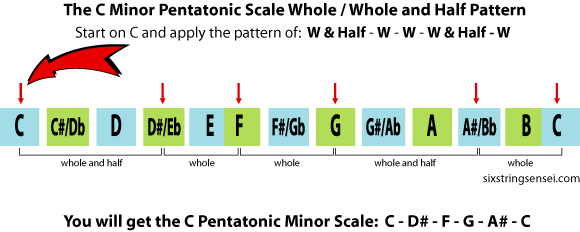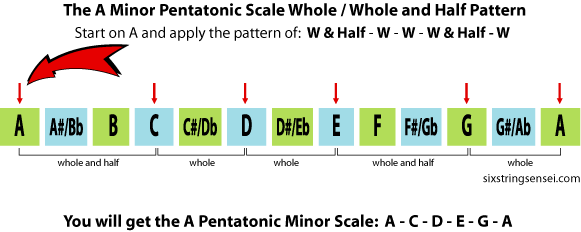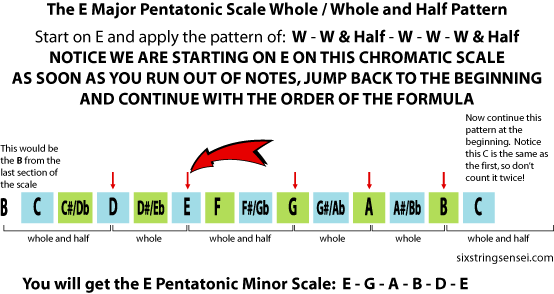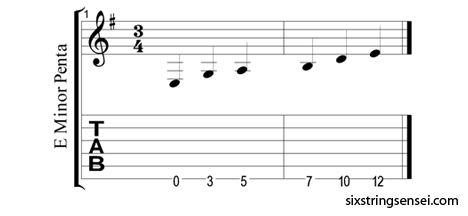Pentatonic Minor Scale Intro
The most OVERUSED scale in rock music
Allright, before we get started I suggest you read the Pentatonic Major Scale Intro lesson. In that lesson I talk about a number of issues pertinent to both the Pentatonic Major and Minor Scales. Ok, moving on…
I can’t say this enough, the Pentatonic Minor Scale is, hands down, the most overused scale in rock. Dozens, if not hundreds of album solos are based on this scale. Hundreds, if not thousands of guitarists know only this scale. Quite frankly, if I had a dollar for every guitarist that has told me, “yeah I can solo” and suddenly begins widdling around at the 12th fret with that “all too familiar pattern” I’d be rich enough to buy dozens of Les Pauls!
The thing is, the Pentatonic Minor has a shape that makes it super easy to remember. Too many songs are based on the key of Em and the 12th fret is very easy to find! The good thing is here you will learn all five positions of the Pentatonic Minor key. Oh! And it gets even better, if you have already learned the five Pentatonic Major Scale positions in the lessons mentioned above, it means you already know the Pentatonic Minor! My Pentatonic Major lessons teaches the scale positions in the key of G. The relative minor of G is Em. So, if you are going to play the Pentatonic Minor in E, you’d be playing exactly the same positions as in the key of G. The only difference is you’d be starting on Position number 5 of the Major Pentatonic. This position, in the key of G starts at the 12th fret E. Check it out, but come back here. So, in brief, this the Pentatonic Minor!
The formula for the Minor Pentatonic Scale
If you’re new to the concept of formula patterns of Whole/Half Steps you should go to my Major Scale Intro Lesson were I go more in depth on this particular topic.
The formula for the Minor Pentatonic Scale is the following:
Whole & Half – Whole – Whole – Whole & Half – Whole
If you apply this formula to the chromatic scale you will get the notes of the minor pentatonic scale. The diagram below shows the application of the formula starting on C to get the C Pentatonic Minor:

I put the previous example there simply to show you how it looks when you apply the formula to C, since C is the note at which the Major Scale is usually started at. But, more commonly, we will see songs based on Am. A minor is the relative minor of C. So to keep in tune with the lessons, next is the diagram which shows the formula applied beginning in A to get the A Pentatonic Minor. By the way, I took the liberty of making the spacing between all notes in the diagrams the same. If you look at previous lessons, you’ll notice I had B-C and E-F stuck together to remind you there is only a half step between these notes. But, by now you should know that. Take a look:

There are a few things worth mentioning about the previous diagram. First of all, the notes are the same as the C Pentanic Major. This is because, like I said, A is C’s relative minor. Secondly, notice I’m starting the diagram on A, which is my first note. But, in practice, the chromatic scale starts on C. You can start applying the formula on the first A the appears and then, when you run out of notes, jump back to the beginning and continue the pattern. It’s a continous pattern. What I’ve done is take notes from the end of the chromatic scale and dump them at the beginning while pushing the other notes down. If I continue to do this, It’s a never-ending pattern.
In keeping with the order of these lessons we will do the same thing for the key of E. E minor that is. In previous lessons we did both the Major and Major Pentatonic Scales in G. G’s relative minor is E. Doing the Pentatonic Minor in E will not only make it easier for you, but it’ll start at the 12th fret. This is were most everybody applies the Pentatonic Minor, so, might as well learn it. As I said in the previous paragraph, you need to learn to apply the formulas on a regular chromatic scale which starts on C. In order to show you how this looks I’m going to do it in the next diagram. Please, don’t get confused. It’s the same thing we’ve been doing. The only difference is that I’m going to beginning where the E sits in the chromatic scale. As soon as I run out of notes, I’ll jump back to the beginning and continue with the order of the formula. Here it goes:

OK! Since we will now continue to learn all the positions of the E Pentatonic Minor, here it is in tab. It’s played on the Low E string starting with the open string and repeating the note again at the 12th fret.

